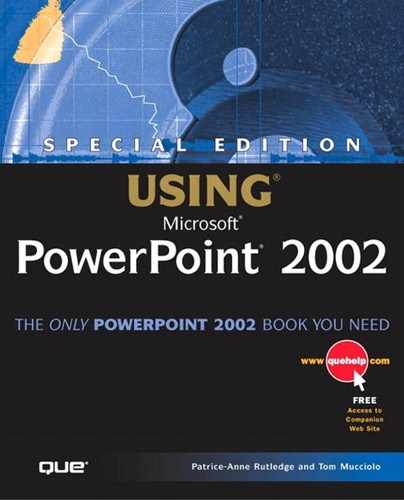Opening a Presentation
You can open an existing presentation in several different ways:
Select More Presentations in the Open a Presentation section of the New Presentation task pane. If this pane doesn't appear, select File, New.
Tip from
You can also open directly one of the previous four PowerPoint files you used by selecting it at the top of the Open a Presentation section of the New Presentation task pane. The File menu also displays these files at the end of the list of menu options.
 Click the Open button on the Standard toolbar.
Click the Open button on the Standard toolbar.Press Ctrl+O from within PowerPoint.
Choose File, Open from the menu within PowerPoint.
Note
You can also double-click a PowerPoint presentation from within Windows Explorer to open it directly and bypass the Open dialog box.
The Open dialog box appears, shown in Figure 2.13.
Figure 2.13. The Open dialog box includes many additional features, including file management and search capabilities.

From the Open dialog box, follow these steps to open a file:
Select the folder in which the file you want to open is located from the Look In drop-down list. From here, you can click the various server and folder icons to navigate to the file you want.
Tip from
You can also use the History, My Documents, Desktop, Favorites, and Web Folders buttons on the left side of the dialog box to navigate to the file you want to open.
Can't find a presentation you know you saved? See “Finding a Saved Presentation” in the “Troubleshooting” section near the end of this chapter.
If necessary, select the type of file you're looking for from the Files of Type drop-down list. This is useful if you have a large number of files on your computer.
When you locate it, click the file you want to open. Its name will appear in the File Name field.
Click Open to open the selected presentation.
The down arrow to the right of the Open button provides several other options. You can also
Open Read-Only Opens the file as read-only. For example, if you've applied a password to the presentation, others may only be able to open it read-only. To make changes and save this file, choose File, Save As from the menu and save with another name.
Open as Copy Opens the presentation as a copy of the original. You might do this if you want to keep your original and create another presentation based on it.
Open in Browser Opens a presentation saved in a Web page format (.HTM, .HTML, .HTX, or .ASP) in your default browser.
Can't open your Web presentation in a browser? See “Opening a Presentation in a Browser” in the “Troubleshooting” section near the end of this chapter.
Exploring the Open Dialog Box
The top portion of the Open dialog box includes several buttons that assist with both opening files and file management. These include
Back Returns you to previous folders or drives you have viewed. It lists the name of the folder as the button name. Click the down arrow to view previous folders.
Search the Web Opens the Pick a Search Engine page on the Microsoft Web site.
Create New Folder Opens the New Folder dialog box in which you can enter a name for a new folder.
Views Includes several options for displaying your files and arranging icons by name, type, size, and date.
Tools Displays a menu that enables you to find, rename, delete, or print files, as well as add them to your Favorites folder, map to a network drive to find a file, or display file properties.
Note
You can perform sophisticated searches by choosing Tools, Search, which opens the Search dialog box. The functionality in this dialog box is nearly identical to what you can do with the Search task pane.
→ To learn more about the Search task pane, see “Using the Search Task Pane” in Chapter 1, “Introducing PowerPoint 2002.”
Setting View Options
You can view files in several different ways in the Open dialog box. Click the down arrow next to the Views button and choose the view option you prefer:
